Alternative sources of heating for a country house: a comparative overview of eco-systems
One of the main expenditures of the family budget is the payment of public heating or the purchase of fuel for heating a house. Every reasonable owner will probably think about real and effective ways to reduce these costs. But you can literally reduce them to a minimum using alternative energy sources. What are they and how are they used? Agree, it's worth finding out.
You will learn all about how to arrange alternative heating for a private house from our article. With our help, you can easily determine the most suitable option for you. A detailed description of the principles of operation of green energy schemes will provide an opportunity to decide which technological method is better to use for heat generation.
The article describes in detail the types of sources of free energy, provides methods for generating heat for use in everyday life. To help independent home masters and zealous owners of suburban estates, photo collections, diagrams and very useful video instructions are attached.
The content of the article:
Pros and Cons of Alternative Energy
Traditional heat sources, used for many years for heating, can be abandoned. Surprisingly, but quite real. Many ardent opponents claim the impossibility of replacing natural resources with environmentally friendly analogues.
An alternative is the energy of the sun, the strength of the wind, the heat hidden in the bowels of the earth, waste products and human activities. Such options are relevant in the modern world, given the general environmental pollution.
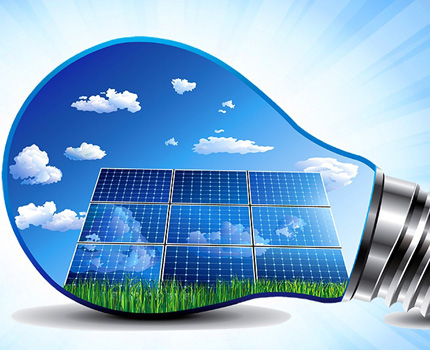
Another significant advantage is the tangible savings when using environmental sources of spontaneous renewable energy. At first glance, it seems that it is unreasonably expensive and is unlikely to pay off.
Having examined the features of each method in more detail, you can see that the eco-project pays off after 4-7 years, and then there are only current expenses for maintaining the mechanisms used in working condition.
The possibility of a full replacement of conventional fuel with alternative has been proven by more than one real example. Homeowners around the world are resorting to environmental heating options. With us, only a few decide to radically change the usual fuel, which is becoming more expensive every year.
The main problem with the use of eco-fuel is significant investment at the initial stage. After all, first you need to calculate in detail the amount of necessary energy for a particular house or cottage. Then find out which type of eco-resources is the most profitable in a particular area.
Next, it is necessary to draw up a plan for the location of the equipment that generates energy, buy everything you need and install.
If relevant specialists will deal with all these issues, the final cost of eco-heating will be very high. To save money, you can try to do it yourself.
To do this, you have to head deep into the topic of alternative energy sources in order to refuse to attract outside help. In this case, the cost of the project will be several times cheaper.
It is the second option that many owners of private homes choose. Their practice proves that becoming non-volatile is real. Traditional fuel can be completely or partially replaced - it all depends on the size of the household, the financial possibilities at the initial stage, and the chosen heating option.
The scope of "green energy" will demonstrate a photo selection:
Types of renewable sources for heating
To heat the house, you can successfully use the energy of wind, sun, earth. As well as biofuels. Let us examine in more detail how exactly to do this and what will be required for this.
View # 1 - wind power
Very successfully, wind energy can be used as an alternative source for heating a country house. This resource cannot be exhausted. It has the property of renewing itself. To use wind power, you will need a special device called a windmill.
The principle of using wind energy
To convert wind power into an alternative heating source, a wind generator is required. They are vertical and horizontal depending on the axis of rotation. There are many manufacturers offering their models to customers.
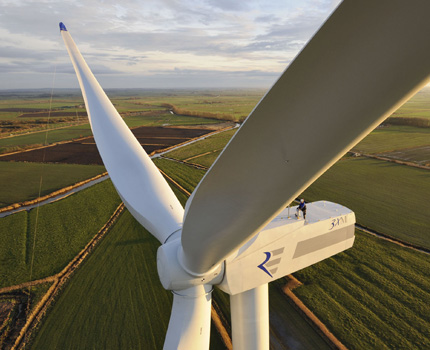
The cost depends on the material, the size of the installation itself and power. You can also build a wind generator on your own using improvised materials.
Any windmill consists of the following components:
- blades;
- masts;
- weathervanes to pick up the direction of the wind;
- generator;
- controller
- rechargeable batteries;
- inverter.
The principle of operation of a wind power installation is based on the strength of the wind rotating the blades of a windmill. The blades mounted on the mast are high above the ground. The higher, the higher the performance. So, to supply one house, a height of 25 m is enough.
Rotating blades drive the generator rotor. He begins to generate a three-phase alternating current, requiring further changes. This current flows to the controller, where it is converted to direct current. It is used to charge batteries.
Having passed through the batteries, the current is equalized and supplied to the inverter, where it is converted into a single-phase alternating current with a frequency of 50 Hz and a voltage of 220 volts. Now it can be used for domestic needs, in an electric heating system.
Features of the location of the windmills
Wind turbines are able to work under certain conditions. Firstly, a wind generator is a rather voluminous structure, requiring an impressive area for the device. A small appliance is not able to satisfy energy needs.
Its height should exceed at least 10 m surrounding houses, trees and other buildings, and power lines and other objects should be located 100 m from the windmill. This requirement is not always feasible - not all owners of private houses have personal plots of sufficient area.
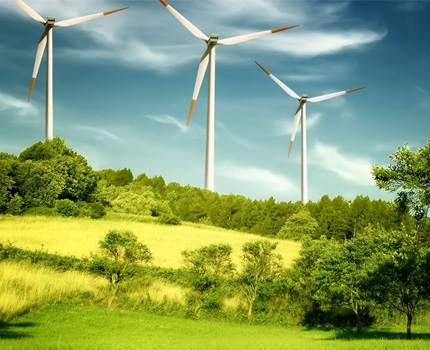
Secondly, it is good when the area in question has good wind potential - an elevation or a steppe zone. To start the generator, a wind speed of 2 m / s is required.
Many models of wind systems designed for use by private households are able to fully cover electricity needs.
So, a 1.5 kW windmill can generate 100-200 kWh per month, depending on the time of year. If you increase the height of the mast, then the productivity will be more than 2 times.
But this will require additional installation costs and consumables. The service life of wind farms is an average of 20 years.
Also on our site there are other materials on the device, types of wind generator, calculation and manufacture with your own hands, and installation.
We suggest you familiarize yourself with them:
- Kinetic wind generator: device, principle of operation, application
- Wind generator for a private house: types and features of units, subtleties of choice, payback calculations + best offers
- How to calculate a wind generator: formulas + practical example of calculation
- Do-it-yourself wind generator from a washing machine: assembly instructions for a windmill
- How to build do-it-yourself blades for a wind generator: examples of self-made blades for a wind turbine
View # 2 - Earth's energy
One of the alternative heating systems is geothermal. It is based on the use of Earth's energy. This is the heat of the earth, groundwater, ambient air, converted by heat pumps (VT). It is important that the temperature of the medium used by the installation is above zero.
The device and principle of operation of the heat pump
For the geothermal system to work, electricity is needed to transfer the heat received. The heat pump, using 1 kW, generates from 2 to 6 kW of heat.
The main principle of the VT operation is to collect heat, convert it, and then transfer it to the heating circuit. This is realized thanks to the device itself.
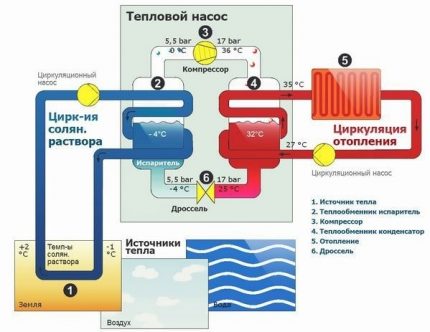
VT consists of 3 closed circuits involved in the process of obtaining heat for heating a private house:
- external - designed to collect heat from sources. An antifreeze or saline solution circulates along the contour;
- internal - filled with refrigerant, often freon;
- heating circuit filled with coolant.
Freon filling the inner circuit is heated by heat coming from the outer circuit. Having a low boiling point, it turns into gas in the first heat exchanger - the evaporator.
Then it enters the compressor, where it is compressed, as a result of which a lot of heat is released, and the temperature of the gas itself rises many times - up to 65 degrees.
Further, gaseous freon enters the next heat exchanger, called a condenser, where it leaves its heat. Freon, having parted with most of the heat, gets under pressure on the relief valve. Here the pressure drops sharply, the refrigerant cools and, having assumed a liquid state, enters the evaporator again.
The heat left by freon in the condenser heats the liquid circulating in the heating system of the home. If the system provides for the installation of underfloor heating, it is possible to achieve the most efficient heating at the lowest cost.
Making the simplest version of a heat pump is easy with your own hands. This will require virtually waste parts, cheaply purchased equipment and, of course, patience. We give a diagram of a thermal system with a fence of heat energy in a well buried in dolomite.
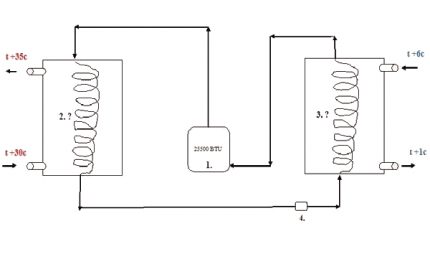
The evaporator of the system considered in the example is connected to a well that draws energy from the soil.
The specifics of the heat pump device for the floor heating system is represented by the photo gallery:
The feasibility of using VT
Heat pumps - VT, taking heat from the environment, are different. It all depends on the type of environment used as a source of heat intake and the type of coolant used.
Accordingly, these types of VT are distinguished:
- air-to-air;
- water-air;
- water-water;
- ground water.
The first two types of pumps are used in air heating systems, and the second two types - in systems with a liquid coolant.

The most beneficial from an economic point of view will be the use of heat water-to-water pump. It is advisable to use this option if there is a non-freezing pond next to the house, into which pipes are placed to collect heat.
The heat pump allows you to get 30 watts of heat from 1 m of the pipeline. Depending on the size of the private home ownership and energy needs, it will be necessary to lay the appropriate number of pipes.
Pumps using air will not replace traditional heating in harsh regions. As for the heat scooped from the soil, this is a very expensive project. Use a horizontal geothermal field device, vertical and cluster drilling.
In the horizontal version, the geothermal field will have to be built to a depth greater than the freezing level. This is about 1.5-2 m. The area of such a field is impressive - from 200 m2.

For the implementation of a vertical and cluster project, drilling at a considerable depth using drilling rigs will be required.
This is a very expensive service. Equipment of this type of heat pumps is advisable for cottage owners who do not think about the cost of work. Heating, using heat from the bowels of the earth, can completely replace solid fuel or gas.
Geothermal heating is most advantageous to use in tandem with a water floor heating device. It allows you to get the most optimal result.
Of the significant drawbacks are the large length of the pipeline for collecting heat, the costly excavation work to install the system, the need for a large area for arranging the geothermal field.
View # 3 - Solar Power
Solar energy emitted by the luminary all year round, even in severe frosts, is able to become an alternative type for heating suburban housing. It is important to learn how to properly assemble and use it in the heating system.
For the collection and conversion of solar energy, solar panels on photovoltaic converters and collectors are used, which are a system of tubes filled with coolant.

The fundamental difference between these converters is that the batteries produce a current that can be used for electric heating of a country house. Collectors are used in water and air heating systems. The most effective option is equipment in the premises of the underfloor heating system.
The opinion that the sun is not able to cope with the heating of the house is valid only in case of improper installation and erroneous calculations of the amount of necessary energy and heat. An optimally selected solar installation is quite capable of providing autonomous heating.
Another question is that for this it will be necessary to invest money in the purchase of equipment, its installation and integration into the existing heating system.
A solar system on photovoltaic converters absorbs solar energy, and silicon solar cells immediately turn it into direct electric current. 1m2 installations capable of generating 120 watts.
In addition to panels that capture solar radiation and convert it, for the solar heating system you will have to install a charge controller, a DC / AC converter and take care of safety - put fuses.

The advantage of the panels is the ability to connect batteries that accumulate excess energy that can be used at night. A significant drawback when using solar batteries is their greatest efficiency in the southern regions. In harsh climates it is not economically feasible to install them for use as the main type of heating.
Solar installations equipped with a tube system are more suitable for regions with cold winters and freezing temperatures. Depending on the structure of the panel and materials, vacuum manifolds, flat and concentrators are distinguished.
The most expensive among them are with vacuum tubes. But they are the most effective at any time of the year and any weather, because they can absorb a wide range of solar radiation. Another advantage is that the vacuum panels operate successfully at temperatures below -35 ° C.
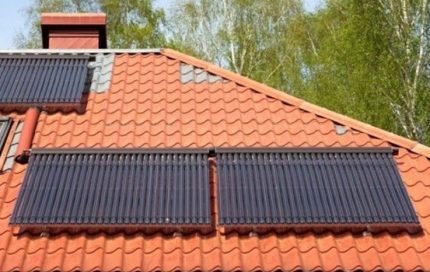
The principle of the collector is that it captures solar radiation, which is converted into heat in vacuum tubes. Then it is transferred to the coolant, which delivers it to the heat exchange tank. Then the coolant enters the heating system.
In more detail, the best designs for solar home heating we reviewed in our other article.
View # 4 - biofuel fuel
One of the effective and affordable ways to heat a country house is a biofuel-fired boiler.
This type of alternative heating uses for its work production waste - husk of crops, wood chips, sawdust and other by-products of the woodworking industry.
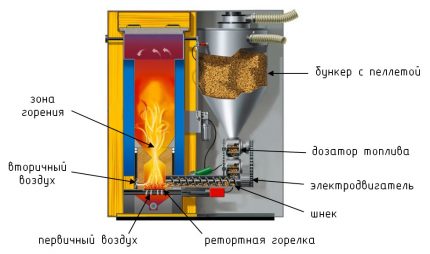
From various wastes, dense compacted granules of small size are made - pellets that are burned in boilers. Compared to ordinary wood, this fuel burns longer and allows you to get more heat.
Large dense briquettes from various kinds of plant waste are also made. Such compressed fuel allows you to get 2-4 times more thermal energy. Its calorific value is up to 5.0 kW × h / kg.
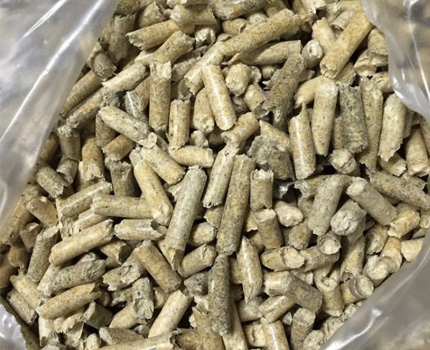
For a gas boiler, biogas can be used. It is easy to obtain in the process of decay of organic waste. To do this, you need to build a sufficiently large tank, place the waste in it, provide for an installation for mixing them.
Under the influence of air and bacteria, the process of decay and gas evolution will occur. It is necessary to establish a pipeline for dumping waste material. Also, to collect gas in special tanks, clean it and move it into the heating system, you need to use the appropriate devices.
An environmentally friendly method of heating using an alternative source of heat is a hydrogen boiler.
The basis of his work is the reaction of the interaction of hydrogen molecules with oxygen, during which a huge amount of heat is released. This type of heating requires compliance with the rules of operation and safety.
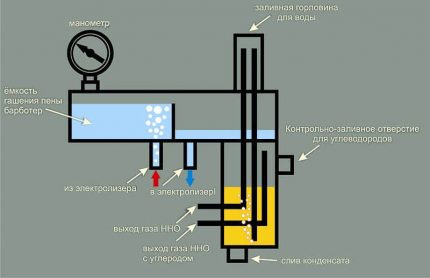
The main disadvantage is the high cost of factory equipment. The way out of this situation is the equipment of the hydrogen heating system on its own.
For its operation, a constant connection to sources of electricity and water, a hydrogen burner, a hydrogen generator, catalysts and the boiler itself will be required. The heat resulting from the chemical reaction enters the heat exchanger, and simple water as waste.
To learn more about biofuels, we recommend that you read our other articles on this topic:
- Do-it-yourself biogas plant for a private house: recommendations for the device and an example of home improvement
- How to get biogas from manure: technology and device installation for production
- Hydrogen heating boiler: device + principle of operation + selection criteria
- How to make a hydrogen generator for your home with your own hands: practical tips for manufacturing and installing
How to save on the introduction of "green energy"?
After analyzing the financial component of alternative types of heating, we can come to a disappointing conclusion - significant funds will be required at the initial stage.
After 3-7 years, depending on the selected heating method, significant savings will become noticeable thanks to the non-volatile system.
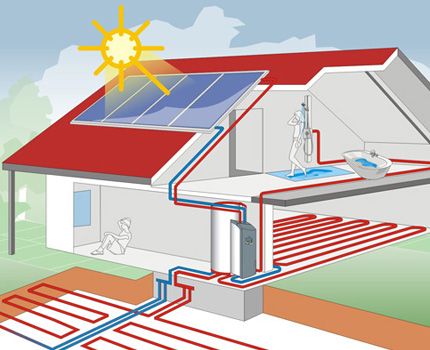
You can save on the use and installation of alternative plants for heat generation. Many home craftsmen are very enthusiastic in creating DIY analogs to factory alternative energy conversion devices.
So, it is quite simple and inexpensive to assemble a solar installation from a hose, which will serve as an additional source of water heating.
Small windmills from improvised means are successfully assembled at home. Well-read farmers living in rural areas are constructing plants for converting biological wastes of plant and animal origin into biogas.

In the future, it is used for the needs of the economy. Depending on the size of the waste fermentation tank and the area of a private house, it is possible to fully provide biogas facilities for all needs.
Conclusions and useful video on the topic
Video about combining alternative sources for generating electricity in a small country house:
A video about making a wind generator with your own hands will help you easily understand the principles of the device:
A short video about using a heat pump:
Video clip about biogas production:
To abandon traditional sources of heating is quite real. To do this, you need to carefully choose an alternative or combine several, based on the characteristics of the area, the area of your country house and house territory.
The energy of the sun, earth, wind power, utilization of household waste of plant and animal origin are quite capable of becoming a worthy replacement for gas, coal, firewood and paid electricity.
Do you use one of the alternative energy sources for home use? Share how much the installation cost and how quickly it paid off.
Or maybe someone from your friends arranged their country house on renewable sources? Using a solar system or a heat pump as an independent source for heat, domestic hot water and electricity?
Tell us about this experience in the comments under the article - a good example will be useful for homeowners who are still doubting the reality of alternative energy.

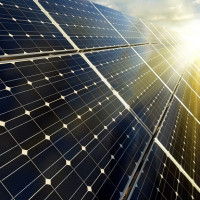 Alternative energy for the home: a review of non-standard energy sources
Alternative energy for the home: a review of non-standard energy sources  Do-it-yourself alternative energy for your home: a review of the best eco-technologies
Do-it-yourself alternative energy for your home: a review of the best eco-technologies 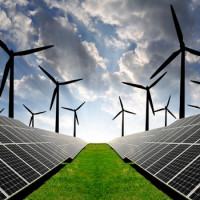 Autonomous power supply for a private house: an overview of the best local solutions
Autonomous power supply for a private house: an overview of the best local solutions 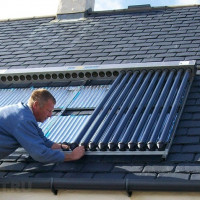 Solar heating of a private house: options and device diagrams
Solar heating of a private house: options and device diagrams 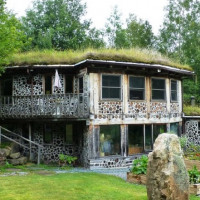 DIY eco-house construction: technological principles and schemes
DIY eco-house construction: technological principles and schemes 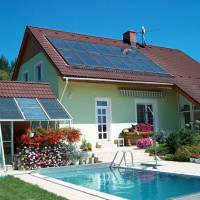 Solar energy as an alternative source of energy: types and characteristics of solar systems
Solar energy as an alternative source of energy: types and characteristics of solar systems  How much does it cost to connect gas to a private house: the price of organizing gas supply
How much does it cost to connect gas to a private house: the price of organizing gas supply  The best washing machines with dryer: model rating and customer tips
The best washing machines with dryer: model rating and customer tips  What is the color temperature of light and the nuances of choosing the temperature of the lamps to suit your needs
What is the color temperature of light and the nuances of choosing the temperature of the lamps to suit your needs  Replacement of a geyser in an apartment: replacement paperwork + basic norms and requirements
Replacement of a geyser in an apartment: replacement paperwork + basic norms and requirements
From the presented alternative energy sources, windmills I immediately dismiss. Only oligarchs who have enough land can build them on their own site. I heard that in the Far East you can get a piece of land for free. Big, I don’t remember exactly how many GA seem to be. Here on such a site you can put a system of windmills, and not in our south, where every hundred square meters of land is worth its weight in gold. It happens that the house and all household buildings on three hundred parts. Where to put windmills in such areas?
Windmills personally impress me very much as a way of generating energy. Full calm happens very rarely, there is always a slight wind, at any time of the year, day or night. Therefore, I think that windmills are better and more practical than solar panels. But to put such an ordinary private trader is not possible - too much land is required and depends on the geolocation. Now, if several owners of neighboring plots are thrown off ... but it is necessary to persuade the neighbors.
I agree, almost everything can be swept away immediately. It is interesting to consider solar panels, but I would use them for electricity.
If my house, then I would definitely build with a simple Russian stove, as an alternative source of heating. Everything else can end, and you can always find firewood.
All this nonsense. Windmills not only depend on the wind, but also create low-frequency noise when working from the blades. Problems with your neighbors are guaranteed. Solar batteries work only during the day, when light is not needed as at night, batteries with a battery system are unprofitable for money. The heat pump consumes electricity and is inefficient. The most normal option is solar collectors, but there are enough problems there.